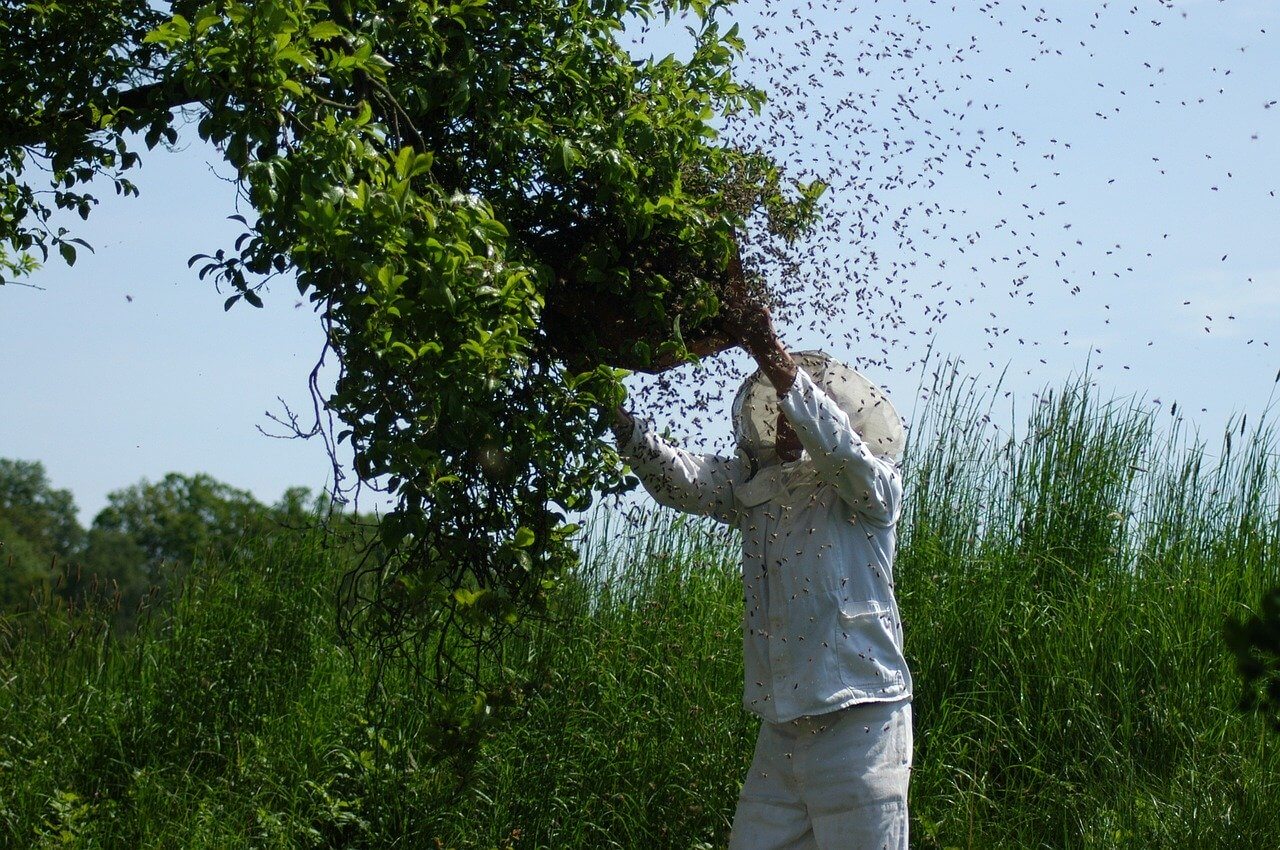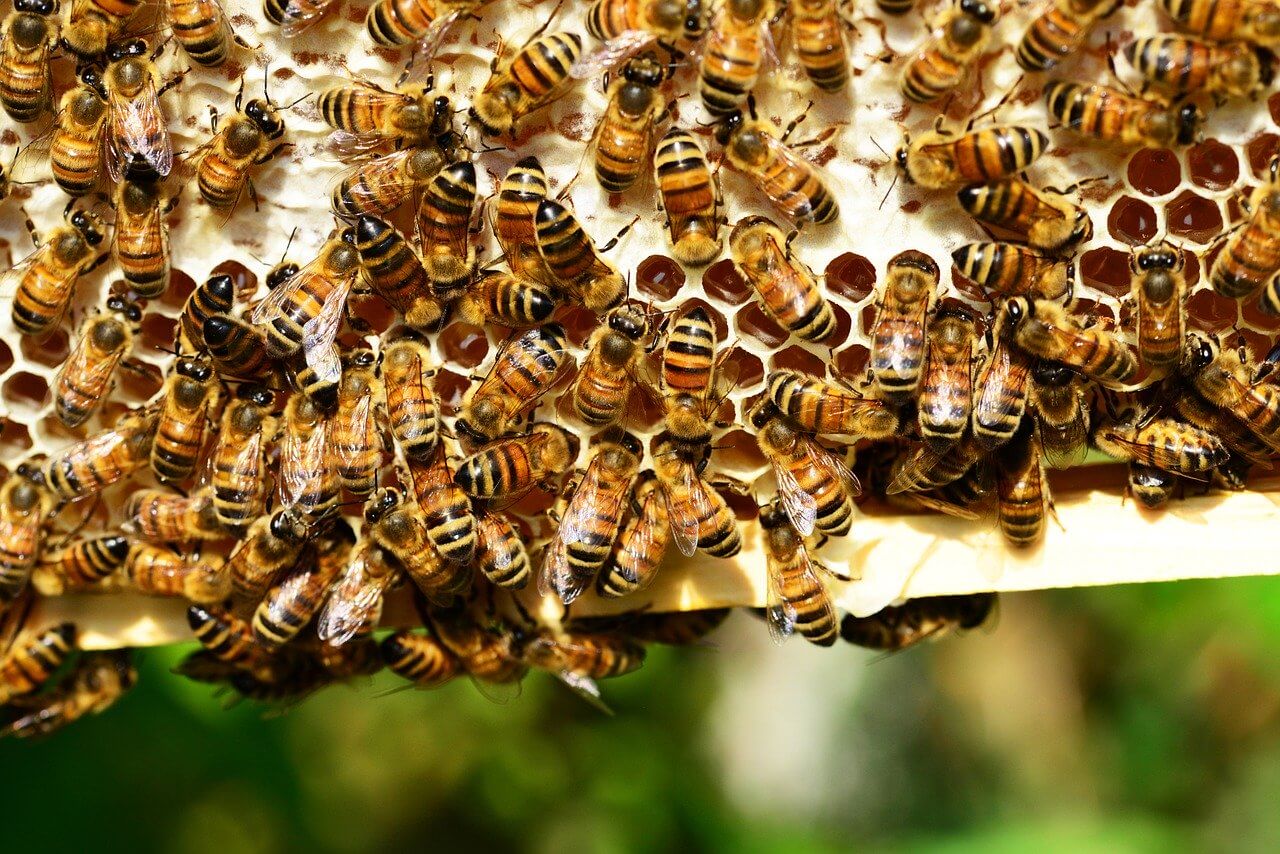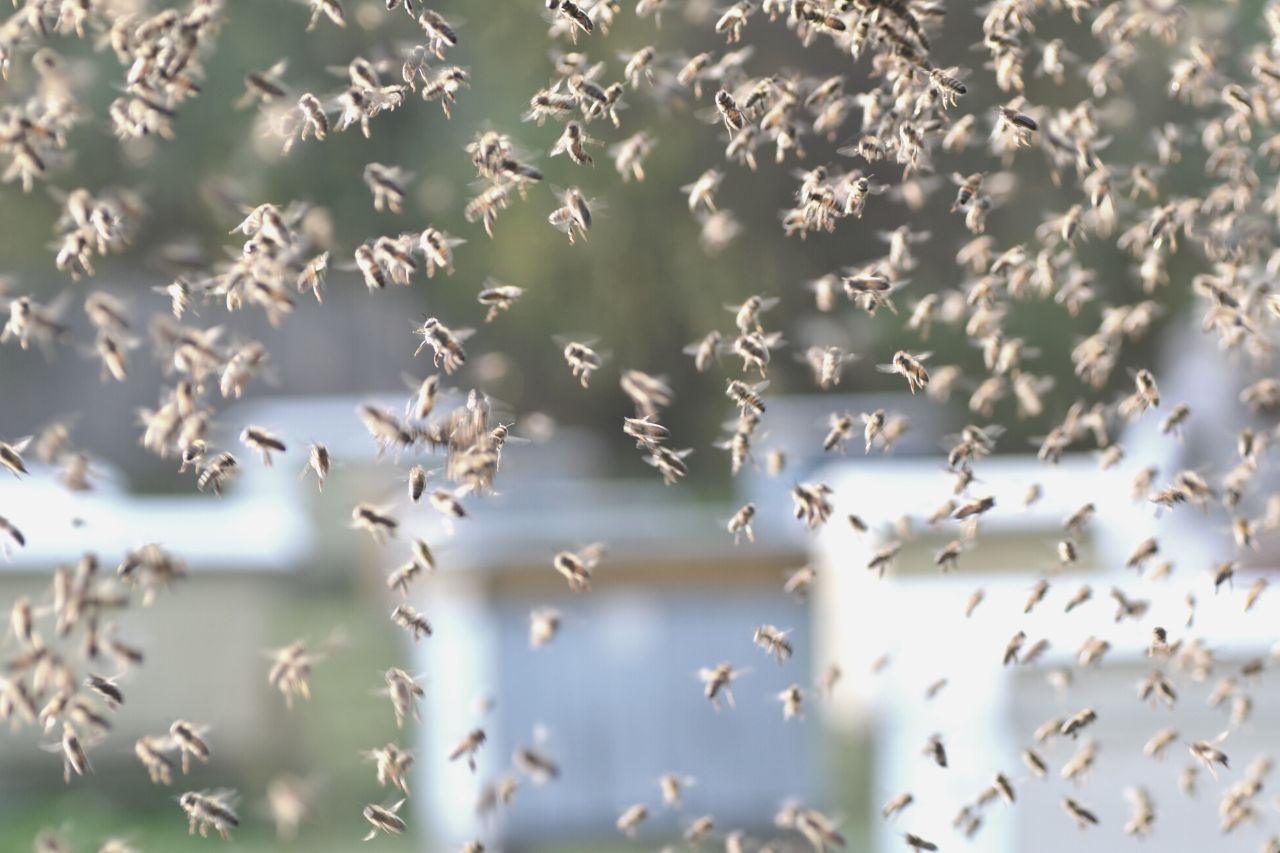There are quite a few factors and specific conditions that encourage bees to swarm. If you are in search of a swarm of honeybees to bring home, you need to understand these factors and conditions. In this article, we discuss what makes bees swarm, how you can find them; how to attract a swarm of honey bees safely and successfully; how to lure bees into a hive and/or gather them. Read on to learn more.
What You'll Learn Today
- Hive Overcrowding Contributes To Swarm Behavior
- How Can You Know When To Look For Swarms?
- How Can You Get Bees To Move Into Your Empty Hive?
- Avoid Disruption When Settling A Swarm Of Bees
- Always Save The Queen
- Relocate At Dusk
- Be Patient
- Frequently Asked Questions
- Q: What happens in a bee colony during a swarm?
- Q: If swarming is a natural behavior, why is it a problem for beekeepers?
- Q: What precise steps can beekeepers take to prevent swarming?
- Q: Why would a beekeeper want to cut the queen bee’s internal wings?
- Q: What are crush barriers, and why should beekeepers try to avoid using them to prevent swarming?
- Q: Why is it ineffective to crush unwanted queen cells to prevent swarming?
- Q: Which types of bees are more inclined to swarming than others?
Hive Overcrowding Contributes To Swarm Behavior

A very successful hive, is almost sure to become full with energetic, busy, hungry bees by the end of winter.
If the home hive is overcrowded, as is often the case in the springtime, this is especially true. When a queen produces a second queen, a swarm is guaranteed.
Swarming Is Seasonal
When the seasons change, from winter to spring, weather is warm and nectar is abundant, bees are more likely to swarm. Hungry, overcrowded bees are highly motivated to seek a new home.
Unpredictable Weather Impacts Swarm Behavior
These days, as the global climate warms, winter weather is often warm enough for swarming to occur.
Additionally, during warm winters, the queen will start building up the numbers of hive inhabitants early. This means that swarming is quite likely very early in the springtime.
How Can You Know When To Look For Swarms?
One of the best ways to predict potential swarming behavior is to keep a very close eye on the weather forecast.
Because weather has been so unpredictable over the last several decades, you will need to stay right on top of it to have some idea of when you should be looking for be swarms.
Enlist The Aid Of Other Beekeepers
You may also want to sign up with a swarm notification list kept by many beekeepers’ associations. Doing this will give you access to a good heads-up when swarms are cited.
How Can You Get Bees To Move Into Your Empty Hive?

If you’re extremely lucky, and you play your cards right, you may be able to simply set up an empty hive and attract a swarm of bees. Remember that the bees are looking for a new home, so if you build it, they may come!
To set up an attractive hive for bees, follow these 5 tips.
1. Use an old brood honeycomb to attract bees
Fresh, new honeycomb is very pale white or light yellow. A good brood comb is quite dark because it has an accumulation of cocoons that have been left behind after fully formed bees have emerged.
The presence of brood honeycomb encourages bees to move into hives that have been abandoned yet still have old honeycomb inside.
This dark, brood honeycomb is quite attractive to bees scouting out a new place to live. If you can obtain some brood honeycomb, place it inside your empty hive or swarm trap to attract scout bees.
You can also use brood comb by melting it down and spreading it on the inside of the hive you hope bees will seek out.
If you use melted brood comb, you can either wipe it on the walls inside the hive, or soak a clean cloth in the melted brood comb and hang it in the open on a tree branch to attract a swarm of bees to that location. Then you can knock them into a box and settle them into your hive.
Just as brood honeycomb attracts bees seeking a new home, other types of hive materials and propilis can also attract bees.
2. Apply simulated or natural pheromones
Spread attractive scents inside the hive and around the entrance. Bees seem to be attracted to domiciles where other bees have lived, so anything that can give them that impression will be helpful.
Nasonov pheromones are extremely attractive to swarming honeybees. This pheromone is normally excreted by bees scouting for a new home.
When the swarming bees smell this pheromone, it guides them to the new site. You can purchase artificially produced chemical pheromones that mimic the scent of the Nasonov pheromone.
You can also used pheromones that have been taken from queens that have been culled from the hive or those that have died.
To extract these pheromones, these queens are distilled in rubbing alcohol to preserve both the body of the bee and the pheromones contained therein.
These pheromones can be added to the inside of the hive by simply wiping them on to the walls and around the entrance with a soaked cotton swab or cotton ball. If you wipe the solution on the walls of the inside of the hive, you’ll need to reapply it frequently because the scent will evaporate and become weakened.
You may also wish to place the cotton ball or the cotton swab inside a plastic bag, seal it and then poke a small hole in it so that the scent is emitted.
3. Lemongrass oil is attractive to bees
You can also use essential oils to attract a swarm of bees. One of the most successful is lemongrass, which smells very much like the pheromones emitted by scout bees.
This strong smelling essential oil is easy to obtain and economical. It just takes a couple of drops on a cotton swab or cotton ball placed inside the hive to attract the swarm. You may also want to put a few drops of lemongrass oil around the entrance to the hive or trap.
Just as with pheromones, you can place a soaked cotton swab or cotton ball inside a sealed plastic bag and then poke a few holes in it and place it inside the hive.
Additionally, if you don’t have access to brood comb, you can use fresh honeycomb, melt it and add lemongrass oil to it. Soak a cloth in it and hang it in a tree to attract a swarm or place the soaked cloth inside your bait hive.
4. Put the empty hive in an attractive location
You may find a wild colony of bees in a hollow tree, in the roof of a cave or in the roof of the shed. Bees choose these areas because they like to be in high, sheltered locations.
Typically, a successful placements of bait hives and swarm traps will be in elevated areas amid flowering trees.
While it’s possible to capture bees with a low placed hive in the open, it’s unusual. They like to have a higher, sheltered setting.
If you’re using a bait box, you may wish to hang it in a tree to get the elevation needed for success.
If you don’t want your bees to be permanently positioned in a high location, you can attract and trap them and move them after they’ve settled in.
5. Design a hive that feels safe
The best thing you can do to prevent your bees swarming away once you’ve lured them is to have comfortable, inviting, attractive hives ready and waiting for them.
Bees like an empty hive that provides safety. They like small, natural cavities that allow them to come and go freely while preventing the entrance of intruders.
For this reason, you may find that bees are attracted to objects such as flowerpots, bee boxes and swarm buckets.
Bees also tend to favor natural materials, but sometimes they will make their home in an object such as an old plastic or metal trashcan. There’s really no accounting for taste.
How To Attract Bees To Your Bee Box
If you cannot lure them to your hive, you may need to bait and trap them. To make a simple be trap, you can just use a plain wooden box that is approximately the size of a brood box.
It needs to have a lid and a few small openings where bees can come and go. The interior of the box should have a volume of approximately 40 liters.
The entrance to the box should be approximately 2 1/2 square inches. The entrance to the box may be circular, square or irregular. Bees are not picky about this.
Avoid Disruption When Settling A Swarm Of Bees
Once the swarm has lighted and settled, they should form a swarm ball so shaking them into a container should not be difficult.
If you’re very lucky, and they have gathered on a low hanging branch, you may be able to simply cut the branch off and put it inside of a container or transfer it to a hive.
Better yet, you might be able to simply put the branch on top of the intended hive or frame where the bees will simply move into the hive on their own. If you’re able to attract the bees directly to the hive, you will have even more chance of success.
A word of caution, while it may seem that your bees have moved quickly into their empty hive and made themselves at home, this behavior may not last.
You may find that they swarm off when the weather warms up again. That’s why it’s very important to do everything you can to ensure that they feel safe and secure in their new home.
How To Trick A Swarm Of Bees To Stay In Your Hive
Always Save The Queen
If the swarm has settled right into a hive, it will be far less likely to fly away again when the weather warms up.
If you must shake them into a container, you run the risk of unsettling them. Furthermore you run the risk of losing the queen. If you lose the queen, you’ve lost the entire swarm.
For this reason, if you need to relocate the swarm from a branch or other location, you should locate the queen first and move her into the intended transfer container.
You may not need to put eyes on the queen, but if you must transfer, be sure to get the center of the swarm. That’s where she will be. You can tell if you have not gotten the queen because the bees will continue to return to the original location.
Note that, after you’ve removed all the bees, you can prevent bees from going back to the original branch by treating it with a bee repellent.
Relocate At Dusk
If you gather bees in mid-day, leave the container that you put them in very near the spot where you found them until sundown. The reason for this is that scout bees are out scouting during the daylight hours and will come back at dusk.
After the sun has gone down, all the bees should have returned and settled in for the evening. This is the time to move the container and relocate your bees to the hive or nucleus you have ready to receive them.
Transfer Bees Promptly
The sooner you can get the bees settled into their permanent hive, the better. Having bees feel at home and comfortable is the best way to ensure that they don’t swarm off again.
Don’t keep your bees in a temporary container, such as a bucket or box, for more than a day. You can keep them in a nucleus for a longer period of time.
They will start building honeycomb and brooding for a few weeks, and then you can move them into a standard hive.
How To Catch & Install A Swarm
Be Patient
Once you have your new arrivals settled into their new hive, give them some space. Don’t inspect for at least a week.
If you can manage to wait for two weeks, this is even better because this will give them a chance to start building fresh comb. Also, the queen can start populating the new hive.
Catching A Swarm Of Bees Can Be A Gamble
You must understand that it takes a great deal of patience to capture a swarm of bees, and you can’t just try once and then give up.
If you decide that this is something you want, to try you must commit to it with the understanding that you may need to try again and again for several seasons before you succeed.
There are upsides and downsides to attracting honeybees rather than purchasing them. On the upside, it’s always good to get free bees if they are not aggressive and if they are productive.
Gathering bees from the wild brings healthy genetic diversity into your be collection. It also adds hardiness to your colony and improves your bees chances of survival.
Frequently Asked Questions

Q: What happens in a bee colony during a swarm?
A: Swarming happens when a bee colony becomes too large and needs to split into two separate colonies. There are several phases involved in this process. They are:
- The “decision” is made for the established queen to leave with half the bees in residence.
- Future queens are prepared.
- The bees in residence divide or split into two roughly equal groups.
- The current queen ceases being fed in preparation for flight, but the bees who will accompany her load up on food.
- The location of a temporary resting place for the split off colony is identified.
- The existing queen and half the existing colony relocate to that location and begin scouting for new permanent hive locations.
- The split off group identifies, accepts and moves to a new permanent location.
- The new queen emerges in the old, established hive.
- The bees which have remained in the old hive accept the new queen.
Q: If swarming is a natural behavior, why is it a problem for beekeepers?
A: If the split off group of bees ends up in an unknown location, it is a great loss for a beekeeper. Literally half of the beekeeper’s tiny stock goes missing! This can reduce current honey production and negatively impact potential honey production. Losing half the hive can also have a negative effect on the colony’s general health and well-being. Swarming can also be an indication of an inattentive beekeeper. It is a sign of overcrowding that may be avoided by keeping a close watch on your colony and providing additional housing to accommodate growth. Early in spring is a good time to add extra supers.
Q: What precise steps can beekeepers take to prevent swarming?
A: As noted, beekeepers should be vigilant about the needs of growing colonies of bees. In addition to providing extra room before it becomes absolutely necessary, an attentive beekeeper makes sure the quality of housing is conducive to keeping bees in place.
- Make sure your bees have ample ventilation in the hives by drilling ventilation holes and keeping them free of blockage.
- Stick with docile races of bees that are less likely to swarm.
- Keep fresh, clean water readily available to your bees.
Don’t destroy unwanted queen cells, use crush barriers or cut the wings of queens. These practices are ineffective and can be cruel. Remember that happy queen bees typically preside over healthy and productive hives.
Q: Why would a beekeeper want to cut the queen bee’s internal wings?
A: Some beekeepers believe that they can control swarming by preventing the queen from being able to fly, but this is an unethical and potentially cruel practice. Cutting her wings may cause the queen to fall onto the ground and die. This is a loss for the colony and can be detrimental to the overall health of the colony.
Q: What are crush barriers, and why should beekeepers try to avoid using them to prevent swarming?
A: Crush barriers are grids made of metal or plastic with holes that allow only the smaller worker bees to pass through. Drones and queens cannot pass through these grids. Crush barriers sharply restrict the movement of the queen and can cause frustration and unnatural behaviors that may prove harmful to the entire colony. For the health of the colony and good honey production, it is very important to maintain the queen’s well-being and mobility so that she can perform her essential duties in the hive.
Q: Why is it ineffective to crush unwanted queen cells to prevent swarming?
Destroying unwanted queen cells doesn’t necessarily prevent swarming behavior. It just spurs the bees to build more queen cells, and you are very likely to miss some of the replacements. You may end up with more extra queens rather than fewer, and swarming may become more likely. It’s better just to be sure of keeping your bees happy, and make sure they have an appropriate, easily accessible place to land nearby I if they do decide to swarm.
Q: Which types of bees are more inclined to swarming than others?
Bees most likely to swarm are Carniolan bees, African bees and Africanized (cross bred) bees. Russian, Cordovan, Italian and German bees have some tendency to swarm. Those most likely to stay put include Buckfast and Caucasian bees.
I think the best and most natural way to attract bees is to have a garden full of green plants and beautiful flowers.